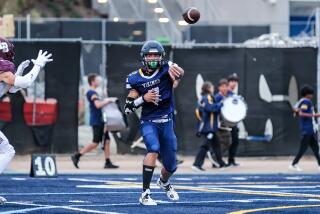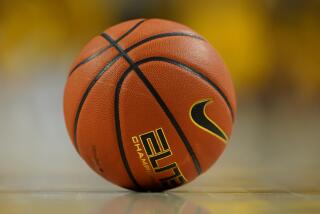SDSU Gets Low Mark in Survey : Academics: Graduation rate for group of Aztec athletes ranks near the bottom nationally.
- Share via
San Diego State’s graduation rate for athletes ranked 254th of 262 Division I schools in an extensive survey published today by The Chronicle of Higher Education.
Of 57 students and recruited athletes who entered SDSU in the fall of 1984, only nine were graduated within five years. The 15.8% rate for athletes ranked behind the graduation rate of 22.2% for the entire student body.
The Chronicle’s study covered years before the NCAA implemented Proposition 48, a measure that established tougher entrance standards for incoming freshmen. Transfers and others were not taken into account. The formula is the same one used by the NCAA to determine graduation rates.
Nationally, the survey found that male basketball players graduate at a much lower rate than athletes and students from other sports. But the survey showed that overall, athletes graduated at a higher rate than regular students. Athletes had a 56% rate compared to regular students at 48%.
SDSU officials would not comment on the survey, for which the school provided only overall numbers and not a sport-by-sport breakdown.
Doug Lederman of the Chronicle, who conducted the survey, said he received a letter from SDSU President Thomas Day in which Day declined to include statistics from specific sports. Lederman said Day cited protecting the privacy of athletes.
The University of San Diego reported a graduation rate of 56.5% for athletes, compared to 57% for the student body.
Among Western Athletic Conference schools that responded to the survey, athletes were graduated at a higher rate than all students. The rate for athletes was 40.7%, but 34% for all students.
Other Southern California schools fared no better.
USC’s football team was ranked among the 20 lowest. Furthermore, Cal State Fullerton, UC Irvine and Cal State Northridge posted low rates in some programs.
USC’s rate for football was 25%, or six of 24 players graduating. It was the lowest figure among Pacific 10 Conference schools except for Arizona, which failed to provide a team-by-team breakdown.
Margaret Gatz, USC’s faculty athletic representative, said 1984 marked a low point in the Trojans’ graduation record. But she said targeting one year for comparison purposes fails to present an accurate portrait of how a school is performing.
Said Trojan Athletic Director Mike McGee: “From 1984 to 1988 the mean entering SAT score for the football team improved 190 points. You will see the results of that factor in subsequent years.”
Fullerton, which has addressed its graduation problem in the past two years, had an 8.3% rate for football and 0% for men’s basketball. Those percentages represented 12 football and six basketball players.
Irvine had a 0% rate in men’s basketball for five athletes. Northridge had a 12.5% rate for football and a 10.7% figure for all 56 of its student athletes who started in 1984. Northridge’s regular student population rate for the same period was 15.5%.
Only Texas Southern (9.4%) and the University of Texas-Pan American (10%) had lower athletic rates of the 262 schools that participated in the survey.
Nationally, Notre Dame and Duke were two of the NCAA’s model programs. Notre Dame’s rate was 81% in football and 75% in basketball. Duke was 92.3% in football and 100% in basketball, though the basketball figure represented only two players.
Michigan was one of the worst big-time football schools with a 17.4% rate. Auburn was 14.8%, Texas 28%, Florida 29.6%, Nebraska 41.2% and Colorado 51.9%.
USC’s Gatz said putting too much emphasis on any given year is unproductive.
“It is quite clear to me and to many others at USC that our graduation rates should be better than they are,” Gatz said.
“This is just the normal kind of variability one would expect in calculating with a very small number,” she said. “There is a kind of standard error you need to put in there in thinking about what is higher and what is lower.”
Gatz said an April 1990 report by the school’s Faculty Senate Committee on Athletic Affairs raised important questions about whether USC was doing enough to help academically troubled students.
The report stated that USC is not spending enough money educating its athletes in comparison to other schools with big-time football programs.
Gatz said the report only partially explains USC’s low graduation rates in football.
“Part of it is who we are admitting and what we can do to provide support for them,” she said. “But this is not just football. We have to ask, ‘Are we doing enough for the academically unprepared student?’ ”
A major reason the Trojan program is lower than the rest of the Pac-10 deals with the players who leave school to try out for professional football, officials said. McGee has initiated a program that allows players who quit early to return to the school to earn their degrees.
“The USC football rate does get very complicated with the push to go pro,” Gatz said.
The USC officials say a more reliable figure would encompass a six-year span instead of the five-year period now used by the NCAA graduation rate formula.
Dolores Vura, director of analytical studies at Cal State Fullerton, agrees. She noted on the survey that 25% of all Fullerton students need six years to graduate.
“While the five-year graduation rate was extended from the traditional four years in an attempt to capture the nontraditional behavior, it does not go nearly far enough,” she wrote to the Chronicle.
Begining next fall the NCAA will use new criteria in collecting information to determine graduation rates of Division I and II schools. A federal law requires schools to publish graduation records of athletes and other students.
The new reporting form will use a six-year figure.
Murray Sperber, author of “College Sports Inc.: The Athlete Department Vs. the University,” challenged those figures.
“One thing that makes me mad about grad rates, is they love to compare it to regular student rates,” said Sperber, a professor of American Studies at Indiana. “It is like comparing apples to alligators.”
Sperber contends that students and athletes lead such different lives that it is impossible to make any kind of valid statistical comparison.
“The main reason why students drop out of the university is financial,” he said. “Their reasons are so far from the reasons that athletes don’t graduate. You’ve got to go behind these numbers.”
GRADUATION RATES
PACIFIC 10 CONFERENCE
All Students Football Basketball School Fresh./Grad. % Recruits/Grad. % Recruits/Grad. % Arizona 4,162 36.0 * * * * Arizona State 4,106 37.6 22 27.3 6 33.3 California 4,401 65.0 31 51.6 3 33.0 Oregon 2,250 44.2 25 40.0 3 66.7 Oregon State 2,077 26.3 19 31.6 6 16.7 Stanford 1,604 88.8 28 71.4 3 66.7 UCLA 3,948 62.6 24 50.0 3 33.0 USC 2,763 53.5 24 25.0 1 100.0 Washington 4,032 51.4 29 31.0 4 25.0 Washington State 2,837 43.2 21 61.9 3 66.7 * Did Not Complete List
BIG WEST CONFERENCE
All Students Football Basketball School Fresh./Grad. % Recruits/Grad. % Recruits/Grad. % Cal State Fullerton 1,929 27.4 12 8.3 6 0.0 Fresno State 1,457 31.0 8 25.0 3 33.0 Cal State Long Beach 2,196 17.5 7 51.0 8 12.5 UC Santa Barbara 2,892 57.7 5 40.0 UC Irvine 2,200 53.8 5 0.0 Nevada Las Vegas 612 20.8 23 17.4 1 0.0 Pacific 739 48.7 6 50.0 5 40.0 Utah State ** ** ** ** ** **
** Declined to Participate
WEST COAST CONFERENCE All Students Football Basketball School Fresh./Grad. % Recruits/Grad. % Recruits/Grad. % Gonzaga 432 48.8 3 100.0 Loyola Marymount 667 63.0 4 50.0 San Diego 758 57.0 1 0.0 San Francisco 438 57.8 * * *4 * Pepperdine ** ** ** ** ** ** Portland 425 49.4 3 0.0 St. Mary’s 438 60.0 3 66.7 Santa Clara 863 76.8 5 60.0 * No Recruits ** Declined to Participate
OTHER GRADUATION RATES
All Students Football Basketball School Fresh./Grad. % Recruits/Grad. % Recruits/Grad. % Auburn 2,927 56.2 27 14.8 6 0.0 Cal State Northridge 2,970 15.5 16 12.5 2 50.0 Colorado 3,346 56.1 27 51.9 3 33.0 Duke 1,501 92.3 26 92.3 2 100.0 Florida 4,596 47.5 27 29.6 5 20.0 Indiana 5,602 57.6 25 56.0 6 66.7 Kentucky 2,572 48.4 22 45.5 5 20.0 Miami * * * * * * Michigan 4,627 76.5 37 56.8 2 0.0 Nebraska 3,190 42.0 68 41.2 1 100.0 Notre Dame 1,796 92.7 16 81.0 4 75.0 Syracuse 2,870 62.1 22 68.2 3 33.0 Texas 6,543 52.0 25 28.0 5 0.0
* Declined to Participate
CONFERENCE GRADUATION PERCENTAGES
All All Football Men’s Bkb Conference Students Athletes Players Players Atlantic Coast 65.6 66.2 55.4 32.0 Big Eight 46.0 42.3 39.4 34.8 Big Ten 59.1 58.0 50.0 43.9 Big West 38.3 39.4 23.8 18.9 Mid-American 46.6 54.4 42.9 40.0 Pacific 10 50.1 52.9 46.6 40.6 Southeastern 46.0 36.4 32.2 14.0 Southwest 49.3 40.6 32.5 23.5 Western Athletic 34.0 40.7 43.1 17.6 Independents 51.4 59.0 51.7 33.3 Public Schools 42.8 45.8 38.9 28.2 Private Schools 70.8 78.8 76.6 63.0
More to Read
Get our high school sports newsletter
Prep Rally is devoted to the SoCal high school sports experience, bringing you scores, stories and a behind-the-scenes look at what makes prep sports so popular.
You may occasionally receive promotional content from the Los Angeles Times.






